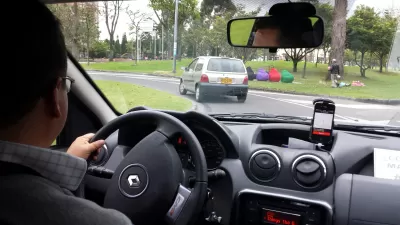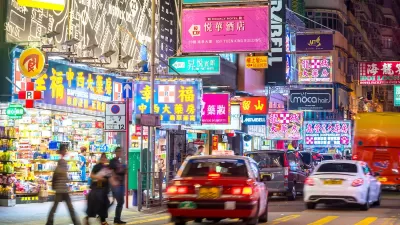A spate of media coverage responded to the news that Uber had released a new feature called "Smart Routes."

Josh Constine reports on the new Smart Routes feature from Uber, described as "a way to let you pay less money for a little less convenience and a little less time saved."
Basically, Smart Routes asks users to walk to a major arterial rather than hailing a car directly to their preferred location. "If you’re willing to set your pickup location anywhere along these Smart Routes, Uber will compensate you with a discount of $1 or more off the normal UberPool price."
Constine notices that the new feature resembles services offered by other transportation network companies (TNCs): "Smart Routes is similar to ride sharing service Loup, which pays people to drive their cars and pick people up on bus-like routes through a city, and Chariot which does the same but with big vans. It’s also reminiscent of Lyft’s HotSpots feature, where passengers can walk to a specific corner to get a discounted fair."
Other writers, however, noticed more that the new feature resembles transit. Matt Buchanan penned an article called "The Uber Endgame," which describes how Uber and Lyft "continue to look more and more like mass transit." Buchanan also notes a potentially dangeroud consequence of the continued advancement of TNCs: "One of the more subtle underlying issues with the rise of Uber is the company’s slow siphoning of the political will to fix existing—or build new—public transit infrastructure in major cities."
Alissa Walker picked up on that theme in a separate post, which includes an appeal for people with choices of transportation modes to continue to take transit, as a civic duty. Her take on Uber's recent advancements: "Sounds a heck of a lot like transit to me. But it’s not public. It’s not accessible, it’s not equitable, and it’s not serving the entire city. I refuse to believe that a fleet of robot cars operated by a single company is ever going to be a better transportation investment than a bunch of really fast fucking trains, smarter buses, solar-powered gondolas, and a comprehensive bike share that also includes e-bikes, kayaks, scooters, and maybe a few of those hoverboard-y things."
Finally, Nate Silver and Reuben Fischer-Baum bring data journalism to bear on the subject, which notes that TNCs could potentially become cost-competitive with cars by closely allying with public transit.
FULL STORY: Uber Tests Bus-Style Discounted “Smart Routes”

Planetizen Federal Action Tracker
A weekly monitor of how Trump’s orders and actions are impacting planners and planning in America.

Map: Where Senate Republicans Want to Sell Your Public Lands
For public land advocates, the Senate Republicans’ proposal to sell millions of acres of public land in the West is “the biggest fight of their careers.”

Restaurant Patios Were a Pandemic Win — Why Were They so Hard to Keep?
Social distancing requirements and changes in travel patterns prompted cities to pilot new uses for street and sidewalk space. Then it got complicated.

Platform Pilsner: Vancouver Transit Agency Releases... a Beer?
TransLink will receive a portion of every sale of the four-pack.

Toronto Weighs Cheaper Transit, Parking Hikes for Major Events
Special event rates would take effect during large festivals, sports games and concerts to ‘discourage driving, manage congestion and free up space for transit.”

Berlin to Consider Car-Free Zone Larger Than Manhattan
The area bound by the 22-mile Ringbahn would still allow 12 uses of a private automobile per year per person, and several other exemptions.
Urban Design for Planners 1: Software Tools
This six-course series explores essential urban design concepts using open source software and equips planners with the tools they need to participate fully in the urban design process.
Planning for Universal Design
Learn the tools for implementing Universal Design in planning regulations.
Heyer Gruel & Associates PA
JM Goldson LLC
Custer County Colorado
City of Camden Redevelopment Agency
City of Astoria
Transportation Research & Education Center (TREC) at Portland State University
Camden Redevelopment Agency
City of Claremont
Municipality of Princeton (NJ)





























